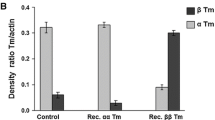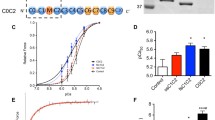Abstract
A novel in vitro motility assay has been developed to study the actomyosin interaction, in which the molecular motor protein myosin has been extracted and immobilized directly from 2–4 mm single rat skeletal muscle fiber segments. This method study was carried out to investigate: (1) the amount of myofibrillar proteins extracted from the fiber segment; (2) the effects of temperature on the speed at which actin is propelled by fast and slow myosin; and (3) the effects of myosin isoform expression on motility speed. Approximately 80% of the myosin and myosin-associated proteins were extracted from the fiber segments, while no significant extraction was shown of the thin filament proteins. Fluorescently labeled actin filaments moved with constant speed in a bi-directional motion over the high-density myosin region in the experimental chamber, and motility speed was highly dependent on the myosin heavy chain (MyHC) isoform extracted. At 25∘C, significant (P < 0.001) differences in motility speed were obtained between type I (1.31 ± 0.23 μm/s, n = 11) and IIxb (5.81 ± 0.35 μm/s, n = 6), or IIb (6.07 ± 0.33 μm/s, n = 8) MyHC isoforms. The motility speed and maximum velocity of unloaded shortening (V 0) in single fibers were well correlated, indicating that filament speed is a good molecular analogue to contractile speed at the fiber level. The effects of temperature on filament motility speed were analyzed from 10 to 35∘C. The Q 10 values, calculated in the 10–25∘C temperature range, differed between slow (4.20) and fast (2.38) myosin. In conclusion, this in vitro motility assay offers a unique possibility to compare the regulatory and modulatory influence of myosin isoforms and thin filament proteins on shortening velocity, at the cellular and molecular level in the same muscle fiber.
Similar content being viewed by others
References
Anson M (1992) Temperature dependence and Arrhenius activation energy of F-actin velocity generated in vitro by skeletal myosin. J Mol Biol 224: 1029–1038.
Bárány M (1967) ATPase activity of myosin correlated with speed of shortening. J Gen Physiol 50: 197–218.
Biosca JA, Travers F and Barman TE (1983) A jump in an Arrhenius plot can be the consequence of a phase transition. FEBS Lett 153: 217–220.
Bottinelli R, Betto R, Schiaffino S and Reggiani C (1994) Unloaded shortening velocity and myosin heavy chain and alkali light chain isoform composition in rat skeletal muscle fibres. J Physiol (Lond) 478: 341–349.
Canepari M, Rossi R, Pellegrino M, Reggiani C and Bottinelli R (1999) Speeds of actin translocation in vitro by myosins extracted from single rat muscle fibres of different types. Exp Physiol 84: 803–806.
Cuda G, Fananapazir L, Zhu W, Sellers JR and Epstein ND (1993) Skeletal muscle expression and abnormal function of β-myosin in hypertrophic cardiomyopathy. J Clin Invest 91: 2861–2865.
Fabiato A (1988) Calculator programs for calculating total from specified free or free from specified total ionic concentrations in aqueous solutions containing multiple metals and ligands. Methods Enzymol 157: 378–417.
Gilbert R, Cohen JA, Pardo S, Basu A and Fischman DA (1999) Identification of the A-band localization domain of myosin binding proteins C and H (MyBP-C, MyBP-H) in skeletal muscle. J Cell Sci 112: 69–79.
Giulian GG, Moss RL and Greaser ML (1983) Improved methodology for analysis and quantification of proteins on one-dimensional silver-stained slab gels. Anal Biochem 129: 277–287.
Goll DE, Suzuki A, Temple J and Holmes GR (1972) Studies on purified α-actinin. Effect of temperature and tropomyosin on the a-actin/F-actin interaction. J Mol Biol 67: 469–488.
Gordon AM, LaMadrid MA, Chen Y and Chase PB (1997) Calcium regulation of skeletal muscle thin filament motility in vitro. Biophys J 72: 1295–1307.
Greaser ML, Moss RL and Reiser PJ (1988) Variations in contractile properties of rabbit single muscle fibres in relation to troponin T isoforms and myosin light chains. J Physiol (Lond) 406: 85–98.
Harada Y, Noguchi A, Kishino A and Yanagida T (1987) Sliding movement of single actin filaments on one-headed myosin filaments. Nature 326: 805–808.
Harada Y, Sakurada K, Aoki T, Thomas DD and Yanagida T (1990) Mechanochemical coupling in actomyosin energy transduction studied by in vitro movement assay. J Mol Biol 216: 49–68.
Hofman PA, Greaser ML and Moss RL (1991) C-protein limits shortening velocity of rabbit skeletal muscle fibres at low levels of Ca2+ activation. J Physiol (Lond) 439: 701–715.
Homsher E, Wang F and Sellers JR (1992) Factors affecting movement of F-actin filaments propelled by skeletal muscle heavy meromyosin. Am J Physiol 262: C714-C723.
Huxley AF (1957) Muscle structure and theories of contraction. Prog Biophys Chem 7: 255–318.
Höök P, Li X, Sleep J, Hughes S and Larsson L (1999) In vitro motility speed of slow myosin extracted from single soleus fibres from young and old rats J Physiol (Lond) 520: 463–471.
Janson LW, Sellers JR and Taylor DL (1992) Actin-binding proteins regulate the work performed by myosin II motors on single actin filaments. Cell Motil Cytoskeleton 22: 274–280.
Julian FJ and Moss RL (1981) Effects of calcium and ionic strength on shortening velocity and tension development in frog skinned muscle fibres. J Physiol (Lond) 311: 179–199.
Kellermyer MSZ and Granzier HL (1996) Calcium-dependent inhibition of in vitro thin-filament motility by native titin. FEBS Lett 380: 281–286.
Kuroda M, Kohira Y and Sasaki M (1994) Conformational change of skeletal muscle α-actinin induced by salt. Biochim Biophys Acta 1205: 97–104.
Kron SJ and Spudich JA (1986) Fluorescent actin filaments move on myosin fixed to a glass surface. Proc Natl Acad Sci USA 83: 6272–6276.
Larsson L, Höök P and Pircher P (1999) Regualtion of human muscle contraction at the cellular and molecular levels. Ital J Neurol Sci 20: 413–422.
Larsson L, Li X and Frontera WR (1997) Effects of aging on shortening velocity and myosin isoform composition in single human skeletal muscle cells. Am J Physiol 271: C638-C649.
Larsson L and Moss RL (1993) Maximal velocity of unloaded shortening in relation to myosin heavy and light chain isoform composition in human skeletal muscles. J Physiol (Lond) 472: 595–614.
Li X and Larsson L (1996) Maximum shortening velocity and myosin isoforms in single muscle fibers from young and old rats. Am J Physiol 279: C352-C360.
Lowey S, Waller GS and Trybus KM (1993) Function of skeletal muscle myosin heavy and light chain isoforms by an in vitro motility assay. J Biol Chem 268: 20414–20418.
Mutungi G and Ranatunga KW (1998) TTemperature-dependent changes in the viscoelasticy of intact resting mammalian (rat) fast-and slow-twitch muscle fibres. J Physiol (Lond) 508: 253–265
Nicolau DV, Suzuki H, Mashiko S, Tagushi T and Yoshikawa S (1999) Actin motion on microlithographically functionalized myosin surfaces and tracks. Biophys J 77: 1126–1134.
Pardee JD and Spudich JA (1982) Purification of muscle actin. Methods Enzymol 85: 164–182.
Ranatunga KW (1984) The force-velocity relation of rat fast-and slow-twitch muscles examined at different temperatures. J Physiol (Lond) 351: 517–529.
Razzaq A, Schmitz S, Veigel C, Molloy JE, Geeves MA and Sparrow JC(1999) Actin residue Glu93 is identified as an amino acid affecting myosin binding. J Biol Chem 274: 28321–28328
Reiser PJ, Moss RL, Giulian GG and Greaser ML (1985) Shortening velocity in single fibers from adult rabbit soleus muscles is correlated with myosin heavy chain composition. J Biol Chem 260: 9077–9080.
Soteriou A, Gamage M and Trinick J (1993) A survey of interactions made by the giant protein titin. J Cell Sci 104: 119–123.
Svensson C, Morano I and Arner A (1997) In vitro motility assay of atrial and ventricular myosin from pig. J Cell Biochem 67: 241–247.
Sweeney HL, Feng HS, Tang Z and Watkins H (1998) Functional analyses of troponin T mutations that cause hypertrophic cardi-omyopathy: insights into disease pathogenesis and troponin function. Proc Natl Acad Sci USA 95: 14406–14410.
Sweeney HL, Kushmerick MJ, Mabuchi K, Sreéter K and Gergely J (1988) Myosin alkali light chain and heavy chain variations correlate with altered shortening velocity of isolated muscle fibers. J Biol Chem 263: 9034–9039.
Thedinga E, Karim N, Kraft Y and Brenner B (1999) A single-fiber in vitro motility assay. In vitro sliding velocity of F-actin vs. unloaded shortening velocity in skinned muscle fibers. J Muscle Res Cell Motil 20: 785–796.
Yamada A, Yoshio M and Nakayama H (1997) Bi-directional movement of actin filaments along bipolar tracks of oriented rabbit skeletal muscle myosin molecules. FEBS Lett 409: 380–384.
Author information
Authors and Affiliations
Rights and permissions
About this article
Cite this article
Höök, P., Larsson, L. Actomyosin interactions in a novel single muscle fiber in vitro motility assay. J Muscle Res Cell Motil 21, 357–365 (2000). https://doi.org/10.1023/A:1005614212575
Issue Date:
DOI: https://doi.org/10.1023/A:1005614212575




